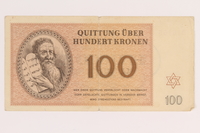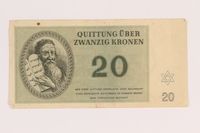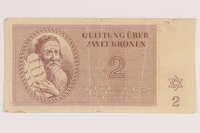Overview
- Description
- Contains a Haggadah created in Gurs internment camp, France, and copy of 10-page handwritten prayerbook(Mahzor) for Rosh Hashanah and Yom Kippur in 1941.
- Credit Line
- United States Holocaust Memorial Museum Collection, Gift of Wolfgang Rauner
Physical Details
- Language
- Hebrew
- Genre/Form
- Haggadah. Prayer books.
- Extent
-
1 folder
Rights & Restrictions
- Conditions on Access
- There are no known restrictions on access to this material.
- Conditions on Use
- The Museum is in the process of determining the possible use restrictions that may apply to material(s) in this collection.
Keywords & Subjects
- Topical Term
- Rosh ha-Shanah. Yom Kippur.
Administrative Notes
- Holder of Originals
-
United States Holocaust Memorial Museum
- Legal Status
- Permanent Collection
- Provenance
- Donated to the United States Holocaust Memorial Museum in 2012 by Mr. Wolfgang Rauner
- Record last modified:
- 2024-07-11 08:24:54
- This page:
- https://collections.ushmm.org/search/catalog/irn59305
Download & Licensing
- Copyright Not Evaluated
- Terms of Use
- This record is not digitized and cannot be downloaded online.
In-Person Research
- Request 7 Days in Advance of Visit
- Plan a Research Visit
-
Request in Shapell Center Reading Room
Bowie, MD
Contact Us
Also in Aaron Rauner family collection
The collection consists of four pieces of scrip from Theresienstadt ghetto-labor camp in German occupied Czechoslovakia, a handwritten prayerbook, and a Haggadah created in Gurs internment camp in France relating to the experiences of Wolfgang Rauner and his family after the Holocaust.
Date: 1941-1943

Theresienstadt ghetto-labor camp scrip, 100 kronen note, acquired by a German Jewish refugee
Object
Theresienstadt ghetto-labor camp scrip for 100 kronen owned by Wolfgang Rauner. The scrip was issued in the camp in 1943. All currency was confiscated from inmates upon entry and replaced with scrip and ration coupons that could be exchanged only in the camp. Theresienstadt was a multi-use camp, acting as a settlement, transit camp, and propaganda tool, for 3.5 years, from November 24, 1941 to May 9, 1945. It was located near Prague, in a region of Czechoslovakia occupied by Germany, renamed the Protectorate of Bohemia and Moravia, and made part of the Greater German Reich. Wolfgang and his family fled Trier, Germany, for Luxembourg in September 1935 to escape the escalating persecution of Jews by the Nazi regime which had ruled since 1933. His father worked to re-establish his food equipment and confectionary sales business. Wolfgang attended local schools as well as Hebrew school run by the close knit Jewish community. His older siblings learned trades to prepare for a future in America. In May 1940, Luxembourg was occupied by Germany. In summer 1941, with assistance from family members already in the US, Wolfgang, 13, his parents, Aron and Neddy, and his two older siblings, Edgar and Gertrude, sailed from Lisbon, Portugal, on the SS Mouzinho, arriving in New York on June 21.
![Theresienstadt ghetto-labor camp scrip, 50 [funfzig] kronen note, acquired by a German Jewish refugee Theresienstadt ghetto-labor camp scrip, 50 [funfzig] kronen note, acquired by a German Jewish refugee](https://www.ushmm.org/media/emu/get?irn=59307&mm_irn=25311&file=secondary)
Theresienstadt ghetto-labor camp scrip, 50 [funfzig] kronen note, acquired by a German Jewish refugee
Object
Theresienstadt ghetto-labor camp scrip for 50 kronen owned by Wolfgang Rauner. The scrip was issued in the camp in 1943. All currency was confiscated from inmates upon entry and replaced with scrip and ration coupons that could be exchanged only in the camp. Theresienstadt was a multi-use camp, acting as a settlement, transit camp, and propaganda tool, for 3.5 years, from November 24, 1941 to May 9, 1945. It was located near Prague, in a region of Czechoslovakia occupied by Germany, renamed the Protectorate of Bohemia and Moravia, and made part of the Greater German Reich. Wolfgang and his family fled Trier, Germany, for Luxembourg in September 1935 to escape the escalating persecution of Jews by the Nazi regime which had ruled since 1933. His father worked to re-establish his food equipment and confectionary sales business. Wolfgang attended local schools as well as Hebrew school run by the close knit Jewish community. His older siblings learned trades to prepare for a future in America. In May 1940, Luxembourg was occupied by Germany. In summer 1941, with assistance from family members already in the US, Wolfgang, 13, his parents, Aron and Neddy, and his two older siblings, Edgar and Gertrude, sailed from Lisbon, Portugal, on the SS Mouzinho, arriving in New York on June 21.

Theresienstadt ghetto-labor camp scrip, 20 kronen note, acquired by a German Jewish refugee
Object
Theresienstadt ghetto-labor camp scrip for 20 kronen owned by Wolfgang Rauner. The scrip was issued in the camp in 1943. All currency was confiscated from inmates upon entry and replaced with scrip and ration coupons that could be exchanged only in the camp. Theresienstadt was a multi-use camp, acting as a settlement, transit camp, and propaganda tool, for 3.5 years, from November 24, 1941 to May 9, 1945. It was located near Prague, in a region of Czechoslovakia occupied by Germany. Wolfgang and his family fled Trier, Germany, for Luxembourg in September 1935 to escape the escalating persecution of Jews by the Nazi regime which had ruled since 1933. His father worked to re-establish his food equipment and confectionary sales business. Wolfgang attended local schools as well as Hebrew school run by the close knit Jewish community. His older siblings learned trades to prepare for a future in America. In May 1940, Luxembourg was occupied by Germany. In summer 1941, with assistance from family members already in the US, Wolfgang, 13, his parents, Aron and Neddy, and his older siblings, Edgar and Gertrude, sailed from Lisbon, Portugal, on the SS Mouzinho, arriving in New York on June 21.

Theresienstadt ghetto-labor camp scrip, 2 kronen note, acquired by a German Jewish refugee
Object
Theresienstadt ghetto-labor camp scrip for 2 kronen owned by Wolfgang Rauner. The scrip was issued in the camp in 1943. All currency was confiscated from inmates upon entry and replaced with scrip and ration coupons that could be exchanged only in the camp. Theresienstadt was a multi-use camp, acting as a settlement, transit camp, and propaganda tool, for 3.5 years, from November 24, 1941 to May 9, 1945. It was located near Prague, in a region of Czechoslovakia occupied by Germany, renamed the Protectorate of Bohemia and Moravia, and made part of the Greater German Reich. Wolfgang and his family fled Trier, Germany, for Luxembourg in September 1935 to escape the escalating persecution of Jews by the Nazi regime which had ruled since 1933. His father worked to re-establish his food equipment and confectionary sales business. Wolfgang attended local schools as well as Hebrew school run by the close knit Jewish community. His older siblings learned trades to prepare for a future in America. In May 1940, Luxembourg was occupied by Germany. In summer 1941, with assistance from family members already in the US, Wolfgang, 13, his parents, Aron and Neddy, and his two older siblings, Edgar and Gertrude, sailed from Lisbon, Portugal, on the SS Mouzinho, arriving in New York on June 21.



